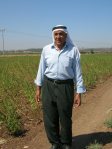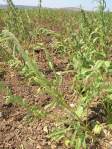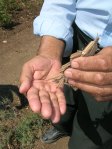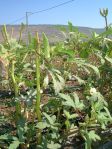While sesame is a crop that was traditionally grown in the Galilee, these days most sesame in Israel is imported from sources in places like Ethiopia. Still, there are a small number of local farmers who continue to cultivate sesame, and recently it was my good fortune to meet one of them.
This past summer, my friend Hadas Lahav, the driving force behind Sindyanna – a fair trade organization that produces zaatar mixture, olive oil and other locally grown products – invited me to join her to see the sesame crop from which she would be purchasing for her zaatar. On a late August day, we drove to Kufar Manda, a large Arab city at the western edge of the fertile Bet Netufa valley, where we met the farmer, Abu Zaki.

Abu Zaki next to his sesame crop
A tall and genial man in his 70’s, Abu Zaki directs us on the short drive from the center of town into the fields, and after passing rows of eggplants, malukhiyeh (mallow) and okra, we arrive at the sesame.


About a week after our visit, I heard that Abu Zaki’s entire sesame crop was ruined – a casualty of some pestilence that affected the soil. But other fields were untouched and Abu Zaki mediated so that another farmer would deliver the goods to Hadas.
A few weeks later I watched Abu Zaki’s sister sitting in front of her house with a large sieve on her lap, sifting through a pile of sesame to clean it. Only these women of the older generation, it seems to me, still have the patience for such labor intensive work. And how long will the traditional drive to grow sesame endure in the face of rock-bottom import prices?

I am very impressed with the bevy of experiences and write-ups on this blog. fascinating, entertaining, bravo.